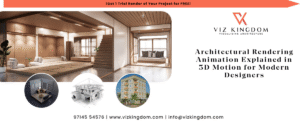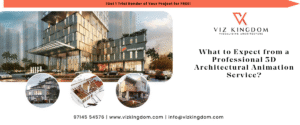
Why Architectural 3D Animation Services Are Essential for Modern Design and Real Estate
In the world of architecture and real estate, visuals can make or break a deal. But when 2D drawings or even static 3D images fall short, architectural 3D animation services step in to bridge the gap between imagination and reality.
These animations don’t just show a structure—they immerse viewers in it. Whether you’re pitching a proposal, closing a sale, or refining a concept, 3D animation makes your design feel real before a single brick is laid.
👉 If you’re ready to transform your blueprints into stunning walkthroughs, explore our 3D architectural animation services.
What Are Architectural 3D Animation Services?
Architectural 3D animation services involve creating photorealistic animated videos that simulate movement through a building or landscape. Think of them as cinematic previews of future construction.
They help clients, investors, and decision-makers experience:
- Lighting changes throughout the day
- Realistic textures, shadows, and materials
- Furniture placement and interior layouts
- The natural flow of movement within a space
As noted by Fortes Vision, these animations help eliminate miscommunication and speed up approvals.
Why They Matter in 2025
A recent Techversol study shows that projects using 3D animation close 40% faster than those using traditional visuals. That’s not just impressive—it’s game-changing.
Benefits include:
- Clearer project visualization
- Better design collaboration
- More compelling investor pitches
- Stronger marketing performance
- Reduced errors before construction starts
When stakeholders see how a space looks and feels in motion, they’re more likely to approve and invest.
Common Use Cases for Architectural 3D Animation
- Real estate promotions
- Interior design presentations
- Urban development concepts
- Hospitality and retail space planning
- Client review and feedback loops
- Public infrastructure awareness campaigns
Even government and educational institutions are now adopting 3D animations to improve communication and transparency.
3D Animation vs Traditional Renders
|
Feature |
Traditional Render |
3D Animation |
|
Output |
Still images |
Video walkthrough |
|
Detail |
Static visuals |
Dynamic with real-world simulation |
|
Impact |
Moderate |
High engagement |
|
Usage |
Brochures, boards |
Websites, ads, presentations |
|
Decision Speed |
Slower |
Faster |
As CadCrowd explains, animations help buyers emotionally connect with projects in ways still images can’t.
How Architectural 3D Animation is Created
The process usually involves:
- Concept review & script/storyboard
- 3D modeling of structure
- Lighting, camera movement, and texturing
- Rendering thousands of frames
- Post-production (effects, narration, music)
👉 Looking for experts who can deliver cinematic quality at scale? Partner with an experienced architectural visualization company that delivers global-standard animations.
What Does It Cost?
Based on Cloud Animations and Whimsitoons, pricing varies depending on animation length, detail level, and purpose. Here’s a rough guide:
- Basic walkthrough (up to 1 min): $800 – $1,500
- Mid-level project (1–3 mins): $2,000 – $4,000
- High-end animations (4–5 mins, VR-ready): $5,000+
Tip: Ask for detailed quotes including number of revisions, video resolution (4K/1080p), and turnaround time.
Trends Shaping Architectural Animation in 2025
- Real-time rendering engines (e.g., Unreal Engine)
- Drone footage integrated with CGI animation
- AI-assisted modeling and lighting setups
- Interactive virtual walkthroughs with VR headsets
- Hyperrealistic materials and motion graphics
According to Cloud Animations, the use of hybrid drone-CGI animations increased by 34% in 2024, especially in large commercial real estate promotions.
Advantages of Using a Professional Animation Service
- ✔️ High-quality visuals = better client confidence
- ✔️ Time-saving collaboration between teams
- ✔️ More engagement on websites and ads
- ✔️ Easier to raise funds and sell off-plan properties
- ✔️ Competitive edge in design tenders and approvals
Final Thoughts
If you’re in architecture, real estate, or design, using architectural 3D animation services is no longer optional—it’s essential. These animations go beyond aesthetics. They clarify, persuade, and sell.
From pre-sales marketing to investor meetings, nothing speaks louder than a motion-activated vision of what’s to come. And with the right partner, it’s more affordable and scalable than ever.
FAQs
1. What is the difference between 3D rendering and 3D animation?
Rendering creates still images. Animation uses those renders to create a moving video through a space.
2. How long does it take to produce a 3D architectural animation?
It typically takes 2–4 weeks, depending on complexity and feedback cycles.
3. Can I use architectural animation in real estate marketing?
Absolutely. It’s one of the most powerful tools for pre-selling properties and showcasing design intent.
4. What software is used for architectural 3D animation?
Tools like 3ds Max, Blender, Lumion, and Unreal Engine are commonly used by professionals.
5. Do these services include voiceover or music?
Many providers offer optional voiceovers, background music, and even captions to enhance storytelling.





